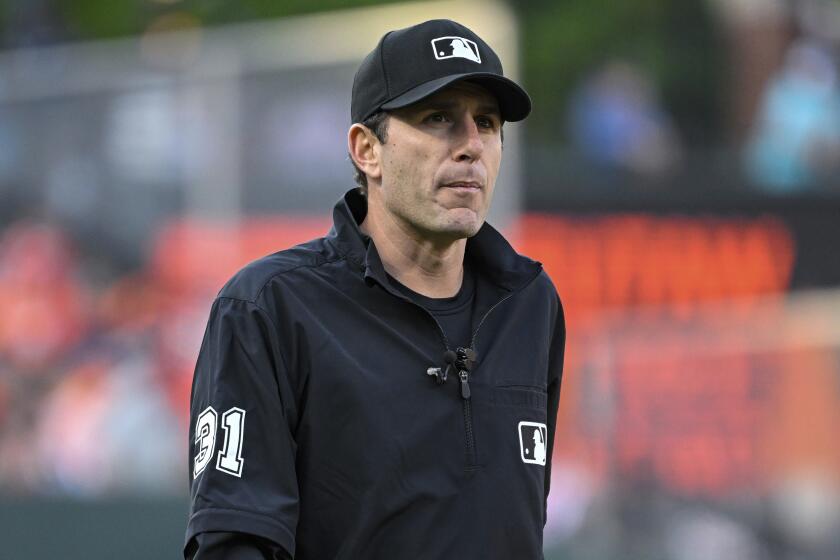For Some, Baseball Was More Than a Pastime
- Share via
The memories are clear as the sky over San Fernando 60-some years ago, the words sharp as the overhand curveball he threw for three decades from mounds throughout California.
The man who was king of the Aces peers out from behind a podium and offers a gentle smile.
Before him sits a rapt audience, several teams of third- and fourth-generation Japanese American ballplayers who have just completed a Labor Day tournament in Woodland Hills without realizing the rich tradition they are perpetuating.
“Good evening, ladies and gentlemen. . . . My name is Pete Mitsui, a Valley resident and an original member of the prewar San Fernando Aces baseball team. . . . To most of you here tonight, the years I’ll be talking about will be way before your days. I hope it won’t be too boring for you.”
Not a chance.
Mitsui, 83, doesn’t miss a detail, bringing to life homespun Sunday leagues played on Valley fields surrounded by citrus orchards, barnstorming the state in Model T Fords, and World War II internment camps where interminable monotony was broken only by the crack of the bat.
It is a long-forgotten chapter of baseball history. The Negro Leagues might have produced better players who endured decades of discrimination, but only Japanese Americans formed leagues that played several seasons behind barbed-wire fences with armed U.S. soldiers watching from guard towers.
Listening to Mitsui, the current Aces were flabbergasted. Most of them are guys with cell phones and mortgages. They knew their team had some sort of history, but this?
“We had no idea the Aces were so old,” said Tod Shimamoto, 39, the team’s player-manager for eight years. “We learned there is so much tradition behind it. This is something to respect. I feel very lucky to be a part of the Aces.”
*
Japanese American leagues sprang up throughout the Southland in the 1920s and ‘30s, organized by ballplayers whose parents had immigrated around the turn of the century. The leagues continue today, and are covered by Rafu Shimpo, the Southland’s Japanese American newspaper, with game stories and statistics.
The Aces are strong as ever, winning their league championship this season in part because of the addition of eight Japanese players living for a year in the United States while attending a baseball academy run by Dodger batting coach Reggie Smith.
“We are sharing culture and our styles of play,” Shimamoto said. “There is a difference between Japanese and American players, and although we are of Japanese descent, we learned to play the American way.”
As did the original Aces.
The father of Berry, James and George Tamura sailed over on a clipper ship in 1910, settled in San Fernando and farmed a dusty patch only a couple of relay throws from where George Tamura, 71, lives today.
Among the most vivid of his childhood memories are those of watching his older brothers and Mitsui play for the Aces before he finally was old enough to take over at shortstop.
The Tamuras and Mitsui remain close friends, and last week the four of them sat around George Tamura’s kitchen table, eating turkey and pastrami sandwiches while reminiscing.
As youngsters, their parents enrolled them in Saturday classes to learn the Japanese language. During their lunch break, they would dash to the baseball field for an hour before returning to class, usually late.
“Our teacher would see us coming in all sweaty and say, ‘You guys stink,’ ” James Tamura said.
Mitsui was 16 when the San Fernando Nippons formed in 1930, playing teams of white players from Reseda, Chatsworth, Van Nuys and Zelzah (now Northridge). In 1934, the team changed its name to the Aces and joined the Japanese Athletic Union.
“The towns were dinky,” George Tamura said. “The only thing anyone had to do on Sunday was watch a game. Everyone came. It was a social thing, free entertainment.”
A few of the players owned Model T or Model A Fords, and when the Aces began playing other Japanese American teams, they would pile into the cars and make hours-long treks to Santa Barbara, Oxnard and San Pedro.
Mitsui was the team’s star, a pitcher and hitter good enough to be selected to the all-time Japanese Athletic Union team of the 1930s. He also played on a Southern California all-star team called the L.A. Nippons that barnstormed around the state playing the best opponents it could find. Mitsui heard recollections from teammates of the 1927 game against a barnstorming team of major leaguers that included Babe Ruth and Lou Gehrig.
With no major league baseball west of St. Louis and baseball’s color line still in effect, an occasional brush with a big leaguer was a big deal.
But the serene life of farming and playing ball ended abruptly with the outbreak of World War II. More than 120,000 Japanese Americans were rounded up and dispatched to remote internment camps, and most of the Aces and their families found themselves in Manzanar, off California 395 near Bishop.
“The day we had to report to the train station in Burbank, I remember it rained so hard,” Berry Tamura said.
Military police armed with bayonets had told them to take only what they could carry, but despite the head-spinning activities of the day, mitts and bats made the trip.
“I studied the Bill of Rights along with everyone else in school,” said George Tamura, who was 15 in 1941. “I saw my classmates and they wouldn’t say a word. Nobody stood up for us. That’s what broke my heart.”
At the 10 internment camps dotting seven Western states, baseball became a pastime in ways most Americans can’t imagine. Leagues were formed and statistics meticulously compiled and distributed in detailed booklets that were a cross between a sports magazine and a game program.
The Aces emerged as the best team at Manzanar, winning the camp championship in 1943 by defeating the Manzaknights, 3-1, before a crowd of several thousand.
“There was a lot of betting on games,” Berry Tamura said. “It was something everyone could get excited about.”
When the war ended, nearly all the Aces returned to the Valley. Many started families, found jobs and had less time for baseball. Mitsui, who had married at Manzanar, found work at a Valley tire company.
Despite the forced relocation that disrupted their lives and caused extreme hardship, Mitsui and the Tamuras seem devoid of bitterness. They remember a lot, but they prefer to talk about baseball.
“The funny part is, after the war we didn’t talk about camp for many years,” James Tamura said. “You can’t live on bitterness, you can’t dwell on it. People treat us very well now.”
*
The Aces disbanded in the mid-1950s when the players became too old to continue. Many never forgot the team’s heyday, however, including catcher Ted Yoshiwara, a longtime member of the pre- and postwar Aces.
Yoshiwara’s World War II experience was vastly different than that of his Aces’ teammates. Because he had moved to Utah a few years before the war, he was spared internment and instead became one of 17,000 Japanese Americans who served in seven European campaigns for the 442nd Regimental Combat Team, the most-decorated unit of its size in U.S. military history.
In the early ‘60s, Yoshiwara’s oldest son, Ted Jr., outgrew youth teams organized through the San Fernando Japanese Community Center and asked his dad about starting a team for older teenagers and adults.
“How about we call it the Aces?” the elder Yoshiwara replied.
The team joined the Japanese Athletic Union and has continued to this day. Ted Jr. and his brothers, Dean and John, played for the Aces during and after their high school careers.
The current Aces include Dean’s son, second baseman Ryan Yoshiwara, 18, who was in the audience Labor Day weekend listening intently to Mitsui talk about the team’s history.
“Baseball runs in my family and playing for the Aces is tradition,” said Yoshiwara, who starred at Moorpark High and is a freshman at Cal Lutheran University. “Hearing [Mitsui] talk about our history makes me want to play as long as I can. The Aces are there every year, and I plan on being part of it.”
More to Read
Go beyond the scoreboard
Get the latest on L.A.'s teams in the daily Sports Report newsletter.
You may occasionally receive promotional content from the Los Angeles Times.











